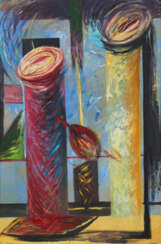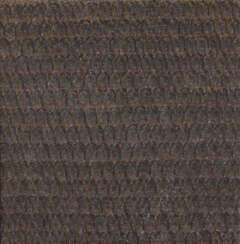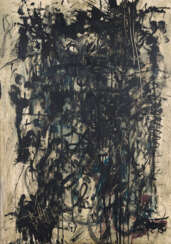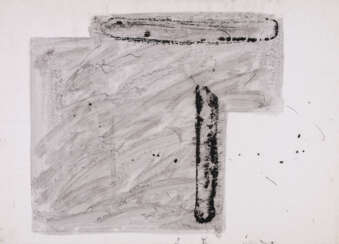
Post War — A1176: One of a Kind. Drawings & Paintings

Wobbe Alkema is a Dutch artist, graphic artist, architect, designer and sculptor. He is known for his abstract and geometric works, often combining elements of constructivism and De Stijl.
Alkema was trained as an architect and then turned to art, studying at the Academy of Fine Arts in Groningen. In the 1920s he was involved with the artist collective De Ploeg, which was active in the northern Netherlands and promoted modernist art and culture.
Throughout his career, Alkema continued to explore the principles of abstraction and geometry in his work. His paintings often feature simple geometric shapes such as squares, circles and triangles arranged in complex compositions that suggest movement and depth. He was also interested in the interaction of colour, using bright, bold hues to create dynamic contrasts and harmony.
In addition to painting, Alkema created a number of sculptural works, including abstract reliefs and freestanding sculptures. He also designed furniture and other functional objects, applying his principles of abstraction and geometric form to everyday objects.
Alkema's work is held in the collections of several museums in the Netherlands, including the Groninger Museum and the Amsterdam Stedelijk Museum. He is considered an important figure in the development of abstract art in the Netherlands, and his work continues to be admired for its innovative use of form and colour.

Stefan Müller is a German abstraction artist who works in Germany.
The process of this artist's work is interesting: sometimes Müller bleaches or paints canvases with batik methods or wipes the floor of the studio with them, so that not only the obligatory traces of paint, but also ashes, dust, dirt, beer and other liquids get on the paintings.

Christian Sery is a contemporary German artist of Austrian origin.
Christian Sery studied painting at the University of Art and Industrial Design in Linz from 1978 to 1984.
His varied work deals with space and the position or representation of his works in it. In doing so, he uses a variety of materials and means of expression.
In 2003, Christian Seri was appointed professor of interdisciplinary and experimental painting at the University of Fine Arts in Dresden. From 2005 to 2012, he was Rector of the Academy of Fine Arts in Dresden.

Christian Sery is a contemporary German artist of Austrian origin.
Christian Sery studied painting at the University of Art and Industrial Design in Linz from 1978 to 1984.
His varied work deals with space and the position or representation of his works in it. In doing so, he uses a variety of materials and means of expression.
In 2003, Christian Seri was appointed professor of interdisciplinary and experimental painting at the University of Fine Arts in Dresden. From 2005 to 2012, he was Rector of the Academy of Fine Arts in Dresden.

Serge Spitzer was an American artist of Romanian origin. He has worked in Jerusalem, New York and Berlin and is known for his installations, sculptures, photographs and videos.
Serge Spitzer studied at the National University of Art in Bucharest from 1969 to 1972 and then at the Bezalel Academy of Art and Design in Jerusalem from 1972 to 1974.
In his work, Spitzer has often explored the relationship between art and its context.

Michael Buthe was a German artist who lived and worked between Germany and Morocco. He exhibited widely throughout Europe during his life and is known for his eclectic and prolific oeuvre which encompasses painting, sculpture, and installation.

Fritz Genkinger is a German artist, member of the German Association of Artists.
He participated in the 1972 Munich Olympics as a draughtsman and designed the posters for the World Championships.
A versatile creator, Genkinger was, among other things, fascinated by Bettingen marble, from which he even carved clear-sounding stone flutes.

Vladimír Novák is a Czech abstractionist artist.
Novak studied at the Prague Academy of Fine Arts. He works in an expressive and expressive style and is known for his series of drawings and paintings containing reflections on the relationship between the figure and space.

Walter Stöhrer is a German painter and graphic artist, a representative of gesture-figure painting.
He studied painting at the Academy of Arts in Karlsruhe and was a member of the Academy of Arts in Berlin.

Peter Herkenrath was a German self-taught artist, one of the brightest representatives of abstract art after World War II.
He created what he called "wall paintings": he applied thick layers of paint in relief with spatulas and brushes. Herkenrath painted many portraits of his famous contemporaries, domestic scenes and still lifes.
Peter Herkenrath was a member of the Association of West German Artists and the Association of German Artists.

Peter Reichenberger is a German artist. In 2006, all of the artist's possessions were donated to his foundation.
Peter Reichenberger studied free painting at the Cologne School of Painting from 1967 to 1973.
Since 1986 he has worked as a free artist. He created his first paintings with a two-colour overlay of fingerprints. His work is a combination of colour, form, rigid structures and patterns.

Gerhard Merz is a German artist. From 1969 to 1973 he studied at the Academy of Fine Arts in Munich. Between 1964 and 1969 expressive pictures were taken and subsequently first metal sculptures. Since the beginning of the 1970s, he has been increasingly working with room installations in which he manufactured references to literary and art history as well as political history, as well as with the development of large-format, monochrome, with lineset nets from pencils covered. At the beginning of 1977, he was represented with his works four times in a row at Documenta in Kassel.

Christian Roeckenschuss was a German artist, a representative of postwar minimalism.
In his work, the artist experimented with stationery, working with grids, wood stencils, paper and plexiglass.

Gerd Baukhage is a German abstractionist painter.
He studied at the Dusseldorf Academy of Art and painted realistic landscapes. Participation in World War II and Soviet captivity strongly influenced the artist's outlook and he moved on to abstract expressive works.
Human suffering and misery in the form of "blockages" and "obstacles" were the theme of Bauckhage's work in the later years of his life. One of his famous creations on the theme of violence and mass murder is the series Execution Machines.

Peter Reichenberger is a German artist. In 2006, all of the artist's possessions were donated to his foundation.
Peter Reichenberger studied free painting at the Cologne School of Painting from 1967 to 1973.
Since 1986 he has worked as a free artist. He created his first paintings with a two-colour overlay of fingerprints. His work is a combination of colour, form, rigid structures and patterns.

Serge Spitzer was an American artist of Romanian origin. He has worked in Jerusalem, New York and Berlin and is known for his installations, sculptures, photographs and videos.
Serge Spitzer studied at the National University of Art in Bucharest from 1969 to 1972 and then at the Bezalel Academy of Art and Design in Jerusalem from 1972 to 1974.
In his work, Spitzer has often explored the relationship between art and its context.

Serge Spitzer was an American artist of Romanian origin. He has worked in Jerusalem, New York and Berlin and is known for his installations, sculptures, photographs and videos.
Serge Spitzer studied at the National University of Art in Bucharest from 1969 to 1972 and then at the Bezalel Academy of Art and Design in Jerusalem from 1972 to 1974.
In his work, Spitzer has often explored the relationship between art and its context.

Alexandra Bircken is a German artist, designer and installer who graduated from the Central Saint Martin's College of Art and Design.
The main theme in Alexandra Birkcen's work is the shell. She explores and combines a variety of materials - wool, concrete, wood, bone, everyday objects and clothing, and creates sculptural objects from them. The artist also uses objects that she encounters in everyday life: cars, motorcycles, surgical shirts, rocking horses, skis. However, she strips them of their familiar contexts and surprises us with unusual combinations.

Stefan Müller is a German abstraction artist who works in Germany.
The process of this artist's work is interesting: sometimes Müller bleaches or paints canvases with batik methods or wipes the floor of the studio with them, so that not only the obligatory traces of paint, but also ashes, dust, dirt, beer and other liquids get on the paintings.

Hans Kaiser was a German painter and stained glass artist.
Kaiser is best known for his large-scale work in Washington, USA, where he created stained glass windows for the National Cathedral. In addition, he performed many commissions in Germany to create windows, stained glass, and glass mosaics for many churches and public buildings.
Hans Kaiser also painted a series of abstract landscapes of the Mediterranean.

Vladimir Kokolia is a Czech painter-engraver, poet and lyricist, professor at the Academy of Fine Arts in Prague.
A versatile and talented artist, Kokolia has mastered many painting and graphic techniques and is known for his color linocuts.

Rupprecht Matthies is a distinguished German artist celebrated for his innovative approach to art that intertwines language and culture. His work, characterized by a deep exploration of words and their impact, bridges the gap between individual experiences and collective expression. Rupprecht Matthies' background in sociology, which he studied before delving into the arts at the University of Hamburg, informs his artistic endeavors, allowing him to craft installations that resonate on multiple levels with a wide audience.
One of Rupprecht Matthies' most notable works is the "¿Being Home?" project, showcased at the Denver Art Museum. This installation is a testament to his ability to engage communities and transform personal stories into compelling visual narratives. Through collaborations with immigrants in Denver, Rupprecht Matthies collected words that held significant personal meanings, crafting them into a vivid landscape of words using materials like wood, Plexiglas, and foam. This project not only highlights his skill in word art but also his commitment to creating art that fosters community engagement and reflection on the concept of home and belonging.
Matthies' art extends beyond installations, as he has won numerous competitions and his works are collected and exhibited both nationally and internationally. His unique approach to creating "word art" allows him to encapsulate values and concepts in physical form, making his contributions to the art world both unique and impactful.
For collectors and experts in art and antiques, Rupprecht Matthies' work represents a fascinating intersection of art, culture, and social commentary. His ability to distill complex societal themes into engaging visual forms makes his work a valuable addition to any collection focused on contemporary art that challenges and captivates.
If you're intrigued by the innovative blend of language and visual art that Rupprecht Matthies brings to the contemporary art scene, consider signing up for updates. This subscription will keep you informed about new product sales and auction events related to Matthies' work, ensuring you don't miss out on the opportunity to own a piece of this remarkable artist's legacy.

Serge Spitzer was an American artist of Romanian origin. He has worked in Jerusalem, New York and Berlin and is known for his installations, sculptures, photographs and videos.
Serge Spitzer studied at the National University of Art in Bucharest from 1969 to 1972 and then at the Bezalel Academy of Art and Design in Jerusalem from 1972 to 1974.
In his work, Spitzer has often explored the relationship between art and its context.


































































